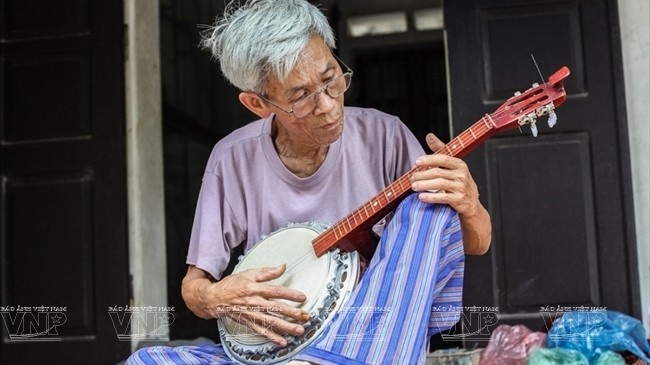Villagers in Dao Xa, most of whom were farmers, began to learn about the making of musical instruments more than 200 years ago. In its most thriving period, there were up to 50 households in the village following the craft. Customers of Dao Xa-made musical instruments included pagoda serving guests, including music lovers, instrumentalists in Thang Long (now Hanoi), and even those from Hue imperial city.
At the age of 80, Soan still masters every step of making instruments, which is executed in the most accurate manner. Born into a family with many generations of crafting instruments, Soan started learning the craft in 1973 from his father and quickly gained prais from making traditional instruments such as the 36-string zither, long-necked three-stringed lute, and the Vietnamese two chord guitar.
Most of the Dao Xa villagers are able to make instruments, but only a few of them can play them well. However, they know exactly what kind of sound the instrument will produce. Soan’s talent is recognised as his musical instruments have a unique sound, especially since he is not a musician himself.
The making of an instrument requires a lot of work with meticulous steps. The first step is choosing the right wood. The best is old wood, which needs to be collected and then dried for nearly two years before it can be used. Most of the crafting steps are done manually, from shaping the body and attaching the neck to the body, to fitting the strings and the final decoration
There are maybe similar instructions for the making of each instrument, but what makes an experienced craftsman stand out is how to produce the sound for that instrument.
During the 1970s-1980s, the number of musical instrument makers in Dao Xa dwindled dramatically since they found it difficult to seek output for the products. Soan was the only one man left to carry the torch, thanks to his enthusiast passion for the craft.
Since the 1990s, when cultural and art activities received more attention from the public, and people became more interested in traditional art forms such as cheo (traditional opera), tuong (classical drama), and hat van (spiritual singing), the traditional craft in Dao Xa has had the chance to thrive again.
Many villagers have learnt the craft from Dao Van Soan, who is willing to provide free training for those who are interested. Now there are around 10 Dao Xa households making their livings by making instruments, many of whom are young people. Among them, the workshop of Soan and his son are mostly visited by customers for their high-quality products.
It takes great love and passion for the makers to pursue the craft. With his lifelong passion for the craft, Dao Xuan Soan has contributed to preserving and developing the production of handmade traditional musical instruments in Dao Xa village to ensure the craft’s continuity.
















